Related Research Articles

Apantesis is a genus of tiger moths in the family Erebidae first described by Francis Walker in 1855. They are found in North and Central America.

Cisseps is a genus of moths in the family Erebidae erected by John G. Franclemont in 1936.

Cisseps fulvicollis, the yellow-collared scape moth, is a species of the family Erebidae and subfamily Arctiinae. It was described by Jacob Hübner in 1818.

Copivaleria is a monotypic moth genus of the family Noctuidae erected by Augustus Radcliffe Grote in 1883. Its only species, Copivaleria grotei, or Grote's sallow, was first described by Herbert Knowles Morrison in 1874. It is found in eastern North America, including Ontario, Tennessee, New York and Maryland.
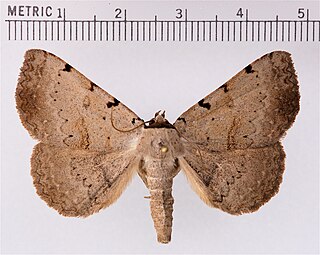
Spiloloma is a monotypic moth genus in the family Erebidae. Its only species, Spiloloma lunilinea, the moon-lined moth, is found in eastern and south-central North America. Both the genus and species were first described by Augustus Radcliffe Grote in 1873.

Ctenucha virginica, the Virginia ctenucha, is a moth of the family Erebidae. The species was first described by Eugenius Johann Christoph Esper in 1794.
Paota is a monotypic moth genus in the family Geometridae described by George Duryea Hulst in 1896. Its only species, Paota fultaria, was first described by Augustus Radcliffe Grote in 1882. It is found in North America.
Andropolia aedon is a moth in the family Noctuidae first described by Augustus Radcliffe Grote in 1880. It is found in North America from British Columbia and Alberta south to California.

Euparthenos is a monotypic moth genus in the family Erebidae erected by Augustus Radcliffe Grote in 1876. Its only species, Euparthenos nubilis, the locust underwing, was first described by Jacob Hübner in 1823. The adults resemble some of the underwing moths of genus Catocala, which are fairly close relatives, in color, pattern, and the habit of resting on tree trunks. But E. nubilis can usually be immediately recognized by the four concentric black bands per hindwing, as opposed to one or two in Catocala. Color morphs of E. nubilis with altered pattern are known, however, and these may be hard to recognize without detailed examination.
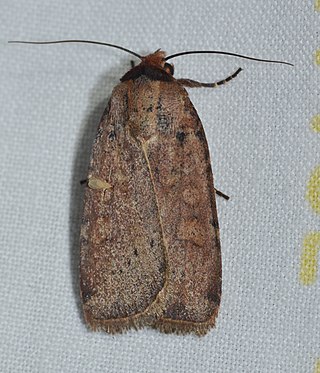
Protolampra brunneicollis, the brown-collared dart, is a moth of the family Noctuidae. The species was first described by Augustus Radcliffe Grote in 1864. It is found in eastern North America from New Brunswick to Alberta in southern Canada, and in the United States from Maine to North Carolina and Tennessee west to Mississippi, north to Minnesota, with scattered records in the west from North Dakota, South Dakota and Montana.
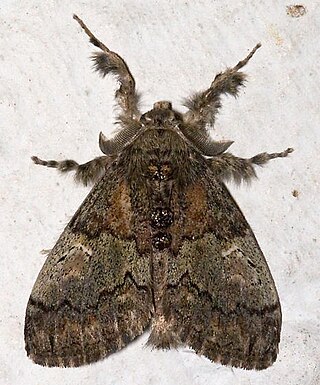
Dasychira basiflava, the yellow-based tussock, is a moth of the family Erebidae. The species was first described by Alpheus Spring Packard in 1865. It is found in North America from Massachusetts and southern Ontario west to Iowa, Texas, south to South Carolina and possibly Florida.
Halysidota cinctipes, the gartered halysidota or Florida tussock moth, is a species of moth in the family Erebidae. It was described by Augustus Radcliffe Grote in 1865. It is found on Cuba, Haiti, the Bahamas and in the US states of Florida, Texas, Arizona and California. The range possibly extends through Mexico, Guatemala, Costa Rica and Panama to Venezuela, Brazil and Peru.
Inopsis funerea is a moth of the family Erebidae. It was described by Augustus Radcliffe Grote in 1883. It is found in North America, where it has been recorded from Arizona and South Carolina.

Cisthene packardii, or Packard's lichen moth, is a moth of the family Erebidae. It was described by Augustus Radcliffe Grote in 1863. It is found in the US from the states of New York to Florida and from Missouri to Texas.
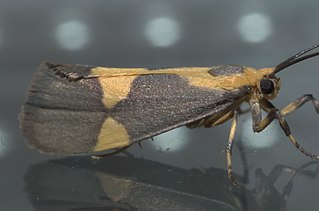
Cisthene unifascia is a moth of the family Erebidae. It was described by Augustus Radcliffe Grote and Coleman Townsend Robinson in 1868. It is found in the southern United States and Mexico.
Pseudohemihyalea labecula, the freckled glassy-wing, is a moth in the family Erebidae. It was described by Augustus Radcliffe Grote in 1881. It is found in the United States in southern Nevada, Utah, from Colorado to Arizona, New Mexico and western Texas.

Ostrinia penitalis, the American lotus borer, is a moth in the family Crambidae. It was described by Augustus Radcliffe Grote in 1876. It is found from Mexico, through Central America to Amazonas, Brazil. It is also found in North America, where it has been recorded from Quebec to British Columbia and most of the United States. The habitat consists of marshes and pondsides.
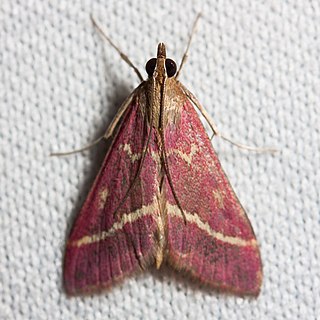
Pyrausta volupialis, the volupial pyrausta moth, is a moth in the family Crambidae. It was described by Augustus Radcliffe Grote in 1877. It is found in North America, where it has been recorded from Oklahoma, Utah, Texas, Colorado, New Mexico, Arizona and California to Chiapas, Mexico.
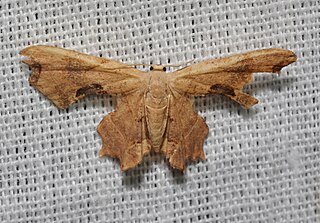
Calledapteryx is a monotypic scoopwing moth genus in the family Uraniidae. Its only species, Calledapteryx dryopterata, the brown scoopwing moth, is found in eastern North America. Both the genus and species were first described by Augustus Radcliffe Grote in 1868.
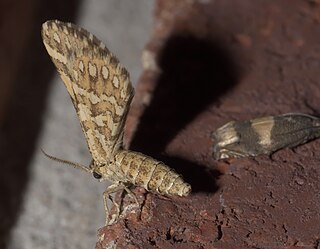
Fernaldella fimetaria, the green broomweed looper, is a species of geometrid moth in the family Geometridae. The species was first described by Grote and Robinson in 1870 It is found in Central and North America.
References
- ↑ "930440.00 – 8267 – Cisseps fulvicollis – Yellow-collared Scape Moth – (Hübner, [1818])". North American Moth Photographers Group. Mississippi State University. Retrieved August 8, 2018.
- ↑ Cotinis (May 23, 2018). "Species Cisseps fulvicollis - Yellow-collared Scape Moth - Hodges#8267". BugGuide. Retrieved August 8, 2018.
- ↑ Savela, Markku. "Cisseps packardii (Grote, 1865)". Lepidoptera and Some Other Life Forms. Retrieved August 8, 2018.